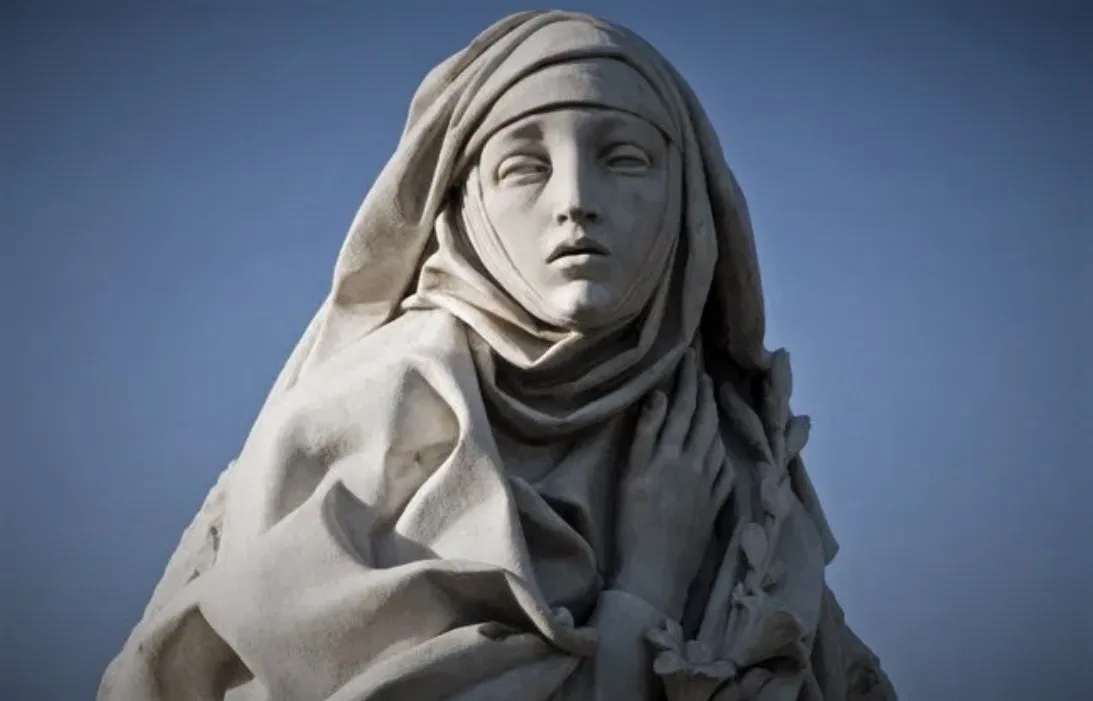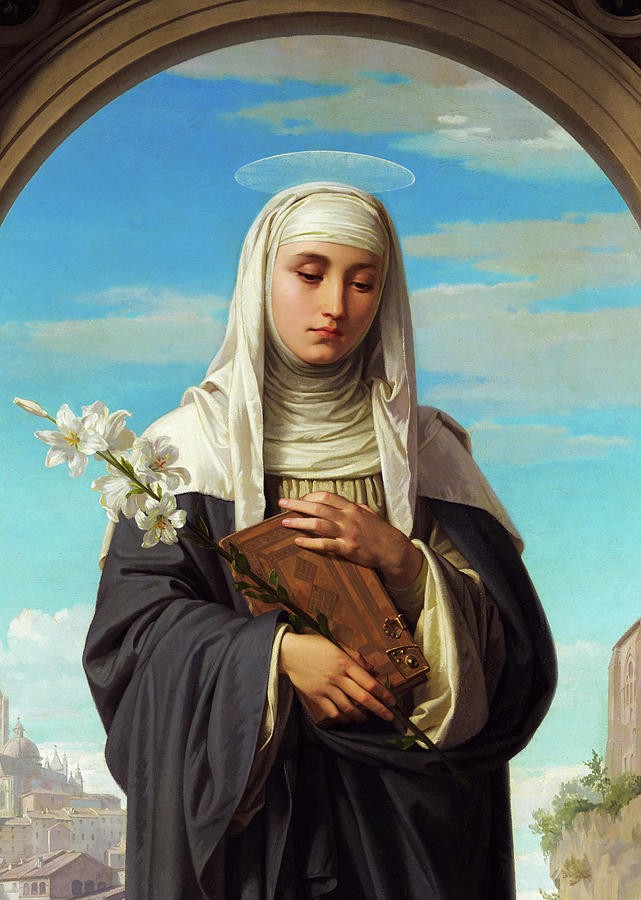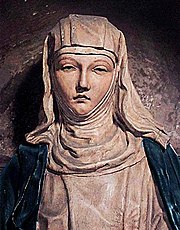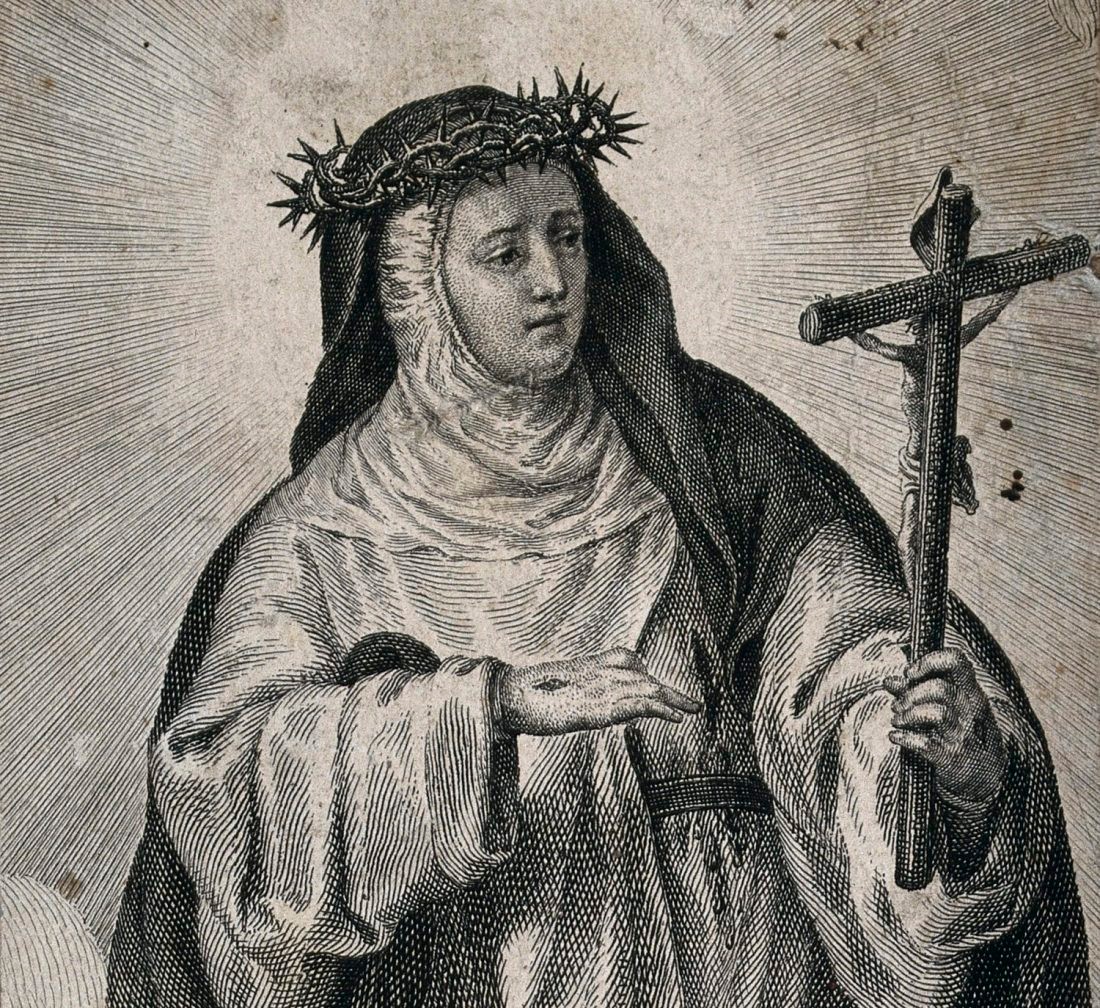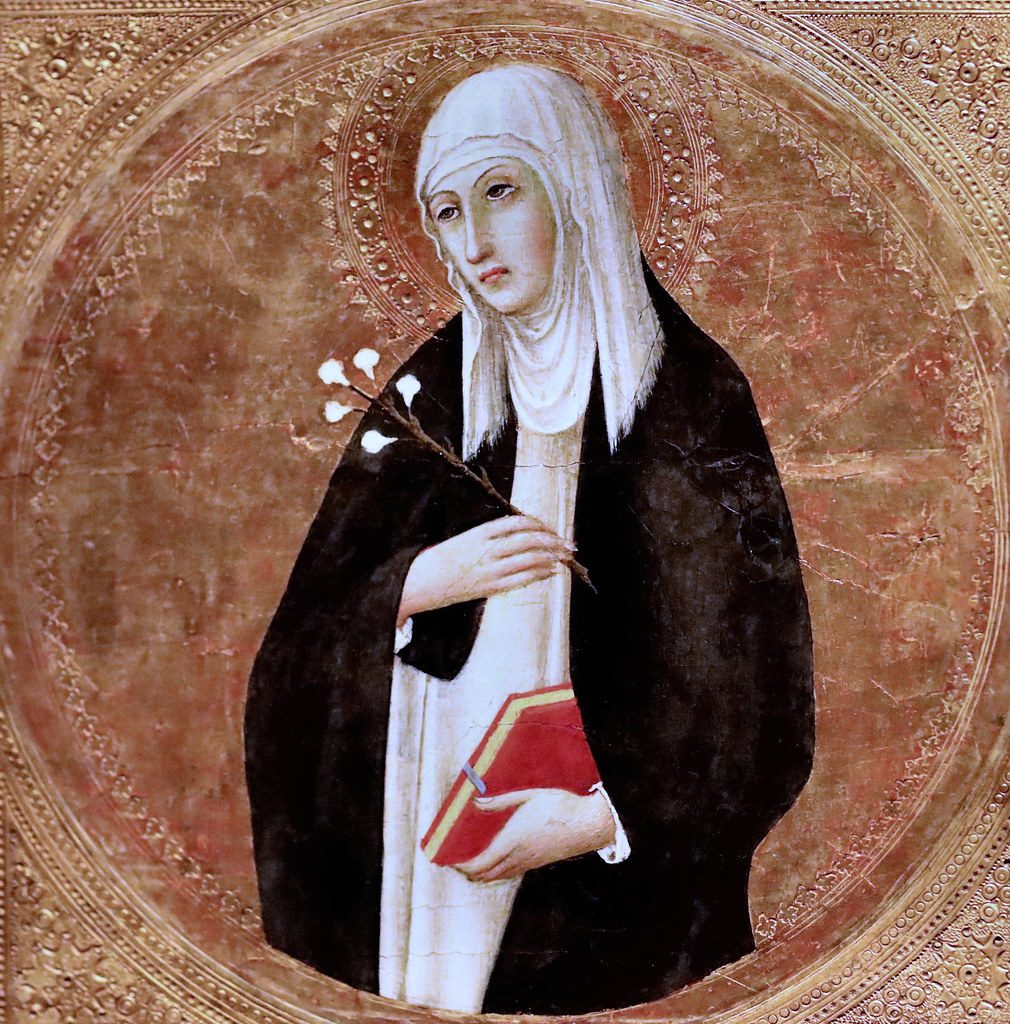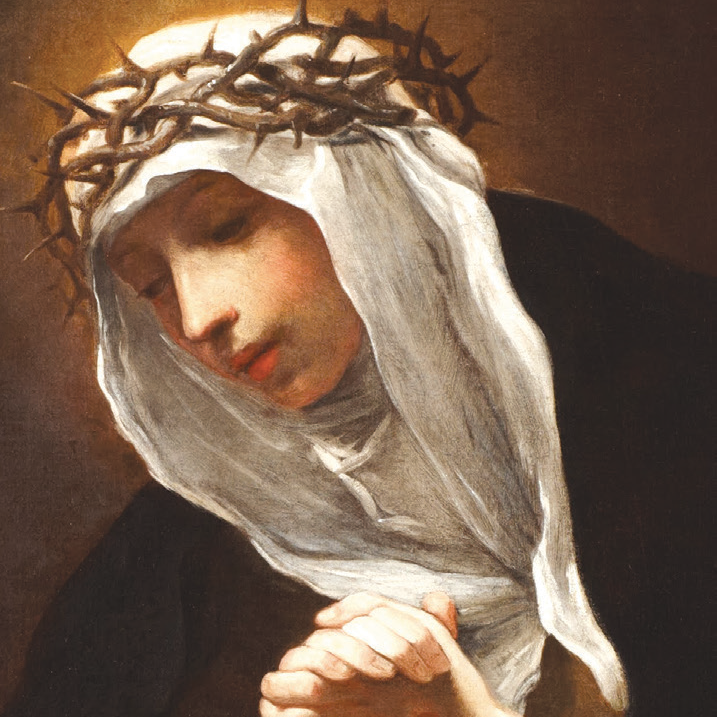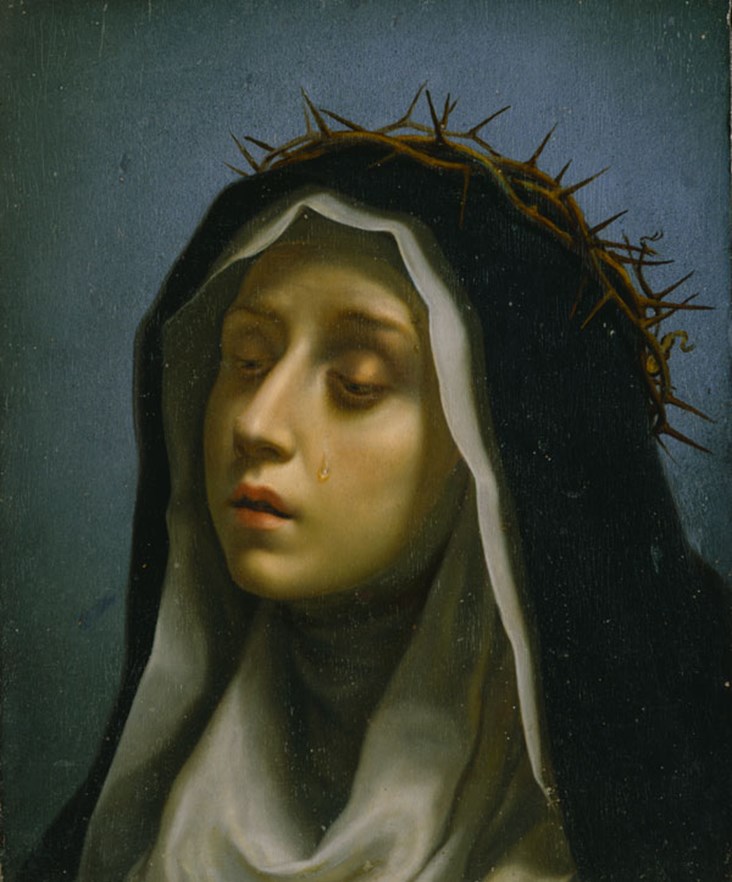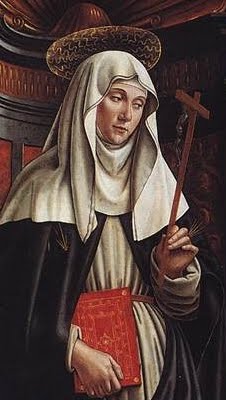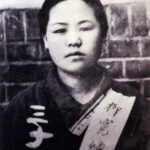
St. Catherine of Siena
The “Mystical Bride of Christ” and Catholic Reformer
Her professed visions and “mystical marriage” to Christ, ring and all, propel Catherine to religious stardom fairly quickly and she becomes a leading voice for peace in a fractured Italy, calling for unification and reunion with the Papal State.
Is she successful in her mission for peace? Is she able to makeover the Catholic Church? Were her visions and extreme asceticism symptoms of some greater issue? You’ll have to listen to find out!
“You are rewarded not according to your work or your time, but according to the measure of your love.”
“It is only through shadows that one comes to know the light.”
“Be who God meant you to be and you will set the world on fire.”
Episode Transcript
(please excuse any errors, spelling or otherwise – audio transcription is tricky)
Hello, and welcome to BROADS YOU SHOULD KNOW the podcast about amazing and noteworthy women from history. I’m your host, Sara Gorsky. And if you’re listening for the first time, here’s what you need to know right off the bat. We are in the middle of the series, they called them crazy. Each week we’re looking into the life and legacy of a woman whom society at some point dubbed crazy. Why were they called crazy? Were they certifiably insane by today’s standards, or were there other reasons that they were shunned as such in their lifetimes? And that’s what we’re here to find out. We split this rich subject matter into a few mini series, starting with prolific broads. And then we moved into the next mini series visionary broads. And as you’ll recall, visionary in this context means that these chicks literally had religious visions.
The last two weeks, we dug into the legacy of Hildegard von Bingen, who was both a prolific writer and a visionary broad, you kind of crossed both of those categories. And if you missed those episodes, on Hildegard von Bingen, you should queue those up after this one as you do not want to miss her. She is incredible. But today, I’m taking us even deeper into visionaries, and into this strange and sometimes wonderful world of medieval mysticism, with none other than Catherine of Siena.
Catherine was declared a doctor of the church in 1970. If you recall, being a doctor of a church means that you had great influence in the development and theology of the church. So in 1970, she was declared a doctor, and she was named a patron saint of all of Europe in 1999. Prior to that, she already was the patron saint of Italy, her home country. So arguably, and a bit surprisingly, she’s considered kind of a bigger deal by the church than Hildegard was, because Hildegard didn’t get canonized and made a Doctor of the Church until 2012.
Catherine, on the other hand, was canonized, initially made a Saint in 1491, which was a mere 81 years after her death. It’s so interesting to compare her to Hildegard because Catherine’s surviving writings in volume are false, far smaller and less dense than held the guards. So from Catherine we’ve got about 380 of her letters, 26 prayers, and four treatises which are known as “Il libro della divina dottrina”, and that translates to “The Dialogue” that’s her big flagship work. And Hildegard left far, far more letters, books, all of it. She just was so prolific with her writing and her music.
But then we also have to remember that Hildegard, who was highly influential several centuries prior to Catherine was tucked away in a tightly knit cloister in the woods of central Germany, where some of her writings and music stayed hidden there in Germany until as late as like the frame 20 century. Whereas Catherine, she was, like, for lack of a better comparison, much more like the Kardashian of her time. It leaves with regards to her public figure celebrity status taunt her beliefs in her practices, right.
Okay, but I’m getting way ahead of myself a little. Let’s go back to the beginning. Catherine was born March 25, 1347, in Siena, Tuscany in Italy, an Italian Broad -we’ve only had a couple of Italian brides on this pod so far. She was the youngest of 25 children. I thought Hildegard is mom was impressive with 10, but friggin 25. Wow. All the sources made sure to mention over half her siblings did not survive to adulthood. But that’s still an insane number of children to have her mom must have been incredibly superhuman or something I have no idea.
And Catherine herself was she was actually born a twin. But her sister Giovanni only lived a very short time after they were born. And they And apparently when Catherine was two years old, her mom had one more baby, her 25th child or 27th child, a daughter that she also named Giovanna. So she had two kids named Giovanni. Catherine’s family was middle class-ish, not particularly poor or particularly rich.
And Catherine apparently had her first vision of Christ when she was only five or six years old. She said that Jesus smiled at her, blessed her and left her in ecstasy. It’s not really surprising then that at the age of seven, just a year or two later, she vows chastity. We’ll fast forward a little bit. There’s not a ton of information about her early life but when Catherine is 16, apparently, her older sister been a Ventura dies in childbirth. And then very shortly after that, her youngest sister, Giovanna dies as well and Catherine was absolutely bereft. Also, so apparently, her parents want to her to marry a bit of a tourist widower so that she could help raise their children. And Catherine was like, “Absolutely not.” And she starts fasting.
Several sources said that she learned this practice fasting from her late sister, Paula Ventura, whose husband apparently, put on surprisingly, was gross and rude, with terrible manners and Bonnie Ventura would refused to eat until he showed better manners. And apparently that worked, I guess. So we need to add that to our toolbox ladies? (Just kidding, please don’t do that).
Now, most of the articles I found refer to Catherine strict “asceticism”. And I, I kind of had a vague definition of asceticism as being some kind of strict fastidious religious thing, but I looked it up so that we would know for sure for this episode, asceticism comes from the Greek word, askeō, which translates to, “to exercise” or “to train”. And asceticism is the practice of the denial of physical or psychological desires in order to attain a spiritual ideal or goal.
Later in her life, when she was writing more, Catherine described how she was able to “build a cell inside her mind”, she would picture her father, as representative of Christ and her mother as the Blessed Virgin Mary. And her siblings were the apostles, and she learned that serving them humbly became an opportunity for her to grow spiritually. And the greater the suffering, the larger the triumph. And so that’s kind of like a little window into, like, what she was thinking while she was fasting – while she was so fastidious here.
Catherine also took this protesting to the next level, and she cuts off her long hair, which severely affected her attractive level rating. At the time period, people were really into long hair or short hair, oh my god. And eventually, her parents give in and they stop trying to force the issue in the stop trying to force her to marry her sister’s widower. And Catherine pretty much this whole time, but especially when her parents were trying to marry her off, she had been kind of begging her parents to be allowed to join the local Order of St. Dominic. And in 1363, apparently, Catherine has a vision of St. Dominic himself. And she goes to her parents and she’s like, “It’s a sign. I have to join them.” But her mom was like, “No way. We don’t want you to join the church. You’re not allowed” and mysteriously, Catherine become super ill. And her mom who is now very worried about losing yet another precious child after all those that she’s lost already, her mom takes her to the local branch of the Dominican Order, and Catherine is instantly healed. And within days, she had taken the vows and she wore the black and white habit as a member of the Third Order of St. Dominic.
Unlike Hildegard she is not cloistered away. She was a – what’s called a “tertiary” which meant that she lived outside the convent at home with her family And apparently she lived in like, almost total silence and solitude, even in her own home like shied away from her family. And at some point she was taught to read either by the Dominicans, when she went to study there, or her family, or both. I’m a little unclear the sources were a little bit mixed on that. But she does learn to read at some point in this time period.
And this whole time, Catherine continues to have visions, andRaymond of Capua, the man who would end up being both her confessor, and he would also end up recording most of her writings and letters, she would dictate all that to him, Raymond said that, after a few years shut away in this lifestyle at home, quote, she was told by Christ to leave her withdrawn life, and enter the public life of the world so Catherine threw up in the shutters, and she started hanging out with her family again. And she also began helping the ill and the poor. And she went around to hospitals and made house calls to care for these folks. And she also starts giving away food and clothes from her family. And apparently, without asking her family, if it was okay with them, I feel like I don’t know why I love this part of her story that she just like, starts giving away her family stuff in the name of God. And apparently, like not, not like a couple things, like a pretty significant cost to her family. She gives away all of this stuff. But Catherine wasn’t asking stuff for herself. She never asked her family to buy her stuff or enjoy.
So she was hardly you know, she was fasting. She’s doing all this stuff. She’s like hardly even eating. She is just giving her family stuff away to the people who who need it day to day. And all of these behaviors of Catherine start to gain the attention of her neighbors. And Catherine develops kind of like a local following in Siena.
And then in 1366, when she’s just 21. Catherine has the vision of all visions, which really becomes it becomes kind of the launch point for everything that follows. She has a vision, wherein she enters a quote, mystical marriage with Jesus. Apparently, Jesus appeared to her, and he declares his intention to make her his mystical bride and offers her a wedding ring. Get this not made of metal, but made of his own flesh, the foreskin from his circumcision. Oh, apparently, I, the sources indicated that apparently that that particular piece of skin was a very popular religious relic in the time period, like more than one church was like I have the Holy foreskin. I will probably never get over how weird the medieval times were. And this is one of the grosser moments someone’s gonna grossed out about it. And maybe you are too. Of course, the ring the Catherine received was invisible to everyone else, only Catherine could see it. So that’s interesting.
I am not entirely clear on the timeline of all of her visions after this like major one because she continues to have them here and there throughout her life. At some point she has a vision of her heart, her heart, like the organ literally being taken by Christ and replaced with his own heart. And after that, after that vision, her heart would throb every time she received the Eucharist or their communion. Once a division she also received communion from Christ Himself. I’m not clear on if it was grape juice or if it was blood. I’m guessing it was the latter because – medieval times. But back to the regular timeline. When word of her mystical marriage vision gets out, Catherine becomes pretty frickin popular in Siena, and the Dominican Order starts getting a lot of attention to and a runs up the flagpole, and Catherine is called to Florence in 1374, to be interrogated by the church leadership for possible heresy. People who are saying they’re talking to God, and are talking dirctly to God, that was a big deal back then if you were if you were a liar.
Now, I’m not going to do a deep dive into Italian and Roman Catholic history at this point in time, but it would seem safe to say generically, Italy is kind of cracking at the seams at this point. And cities and regions are all experiencing a lot of fighting. And there’s like a generally large movement to kind of wiggle out from under the thumb of the Catholic the Roman Catholic Church. So Catherine’s direct connection to Christ and God with through these visions, made her a really influential voice and tool for the Dominican leadership. And at this trial, not quite called an inquisition by any of my sources, but it seems sort of like an inquisition, Catherine is deemed “Orthodox” which makes her official in the eyes of the church. And so she is officially got like the rubber stamp of approval.
And so she begins kind of expanding her ring of influence. And she starts traveling with her followers throughout northern and central Italy. And she’s advocating for a reforming the clergy. She is advising people that they can repent and renewal is possible through the “total love of God”.
Traveling isn’t the only way that she spreads her influence. She starts dictating letters, mostly she dictated, she didn’t write them herself. We understand. But she wrote letters to men and women alike. And she also wrote letters and begged figures in authority to come to peace. So she’s she’s kind of writing to these disparate parties between republics and principalities all over Italy, and she’s like, “please, please, please, we need the peace.”
And she travels in 1375 to Pisa and she tries to convince Pisa and Lucca, another city, to come back into the Pope’s fold. They were trying to kind of go rogue on the Pope. And and she was like, “you have to come back”.
And she also at this point, it starts promoting the idea of launching a new crusade. My sources didn’t say why she was kind of bent on this crusade angle, but part of me probably thinks that like, ‘Okay, well, everyone will come together under the Catholic Church, if we come together to fight the Muslims’ is kind of like the generic feeling I got from from the sources I was reading.
While she’s in Pisa, that same year, she has another vision. And she claims in this division to have received the stigmata for those of you not religious or not into horror movie this tomato are the wounds of Christ, right the the hands the pricks from the thorns and the cut on the ribs. But as with her wedding ring, the wounds, stigmata wounds were not visible, Catherine and Catherine alone could feel them. But stigmata is huge in religious lore.
Towards the end of 1375, she returns to Siena, and she attends a political prisoner and his execution. And you know, she’s this whole time, she’s still preaching. She’s still doing doing all this, this touring and public speaking. And then in June 1376, Catherine goes to Avignon as an ambassador of the Republic of Florence, to make peace with the Papal States. But this, apparently, was unsuccessful, and in a major power move, the Florentine leaders who had like, basically shunned her and shut her out of those negotiations, they sent ambassadors to negotiate their own terms. And Catherine is pissed off, and she writes them an astoundingly bold reply, … she reads them the riot act, let’s just say.
While she’s in Avignon, she also is trying to convince Pope Gregory XI, to return to Rome. So at this time, the center of the church is in Avignon. It’s not in Rome, where it had always been before. And it would appear in the reading that I did that Catherine really believed that this was part of the fracturing that they were experiencing in Italy, and in the church, and that if he would just return to Rome, they would be able to bring everybody together again.
And Gregory, Pope Greg, and apparently she called him “Papa” and “daddy”, by the way, she called the pope in her letter she called the Pope “Papa”, which I find also just amazing. Apparently, Gregory did end up returning his administration to Rome in January of 1377. But according to Wikipedia, we aren’t sure “To what extent this was due to Catherine’s influence.” So thanks Wikipedia for something but nothing at the same time.
So I’m Catherine ends up returning to Siena, and she spends the early part of 1377 founding a women’s monastery outside the city. And she goes to Rocca d’Orcia, about 20 miles from Siena, on a local mission, making peace and preaching.
And it’s during this next period of time, late 1377, she had the vision that would end up becoming what is widely known as her most important surviving work, which we’ve already said, The Dialogue. The Dialogue is said to have been written while she was in a state of ecstasy. A state of ecstasy is very complicated and the definition of it seems to kind of change with each person that kind of goes through it but for for purposes of simplicity it’s kind of like a trance when she’s receiving these visions. So she can’t hear see other things around her. She’s just connected into God and Jesus and in I’m just gonna say it just just say “a trance”. And so, the dialogue basically is a is just a writing of what she experiences and in the whole book is basically a conversation between her and God. It is widely read, widely studied in seminary and otherwise. And I, for the sake of time, I’m not going to like dig into it, definitely look it up. If you’re curious about it, many of her famous quotes came from that book. But I’m gonna keep going with her storyline…
Late in 1377, or possibly early in 1378. She travels again to Florence, this time at the order of Pope Gregory to try to bring peace between Florence and Rome. But Gregory dies just a few months later. And immediately following there’s riots, and revolts, and Catherine is nearly killed. Some sources even said assassinated, she was nearly assassinated in all the violence that followed the death of the Pope.
Finally, about six months later, peace was agreed between Florence and Rome, and Catherine was able to return to Florence. But not for long because the new Pope, Urban VI, in November 1378, he summons her back to Rome, to join his court to try to convince all the nobles and Cardinals of his legitimacy. So there’s a lot of “is he legitimate pope is he not ?” and I’m not going to dig into it, because that’s not what I want to focus on. But essentially, Catherine would send out a bazillion letters on behalf of Pope Urban.
And she also helped him to kind of reorganize the church and restructure it and try to kind of bring back some of this unity and bring back the peace. She also tried to win back, apparently Queen Joan I of Naples. She had been excommunicated by Urban because she supported one of the antipopes. And Catherine was trying to get her to come back and to claim obedience to Urban. But, you know, unification was her kind of big MO, especially at the end of her life here. And Catherine would end up staying with Pope Urban’s court in Rome until she died in 1380.
So St. Catherine dies in Rome, April 29 1380. She was only 33 years old, but she apparently had suffered a stroke eight days earlier. That’s the description that Encyclopedia Britannica gives us her death. But it wasn’t a mere stroke, guys.
Remember, this asceticism stuff we talked about just a little bit ago at the beginning of the episode? So this ascetic practice continues throughout her life, not just in protest of having to get married, but she continues to follow that throughout all of the things we just talked about. She’s constantly fasting, she refuses to eat anything other than apparently raw vegetables and the Eucharist, her communion, and she claimed that she found no nourishment in earthly food.
And this extreme, basically anorexia as we now define it took a huge toll on Katherine’s body. She kind of was wasting away and everyone could see it in real time. And the clergy and her fellow sisters, even her confessor, he ordered her to eat properly, but if she did, she would just throw it up and have severe stomach pains. And of course, for Catherine, it was just another penance to bear. So she didn’t think more heavily about it or change her ways.
But in Rome, it all catches up with her and her body stops working properly. She can’t walk, she has the stroke, and then she dies about eight days later.
Man, I don’t even know where to begin when we circle back to the question of Crazy, right? Catherine has visions as young as five. And it would seem to me as and many of my sources that her visions came at convenient times. She marries Christ so she can’t marry her sister’s widow. She falls ill when her mother, mother won’t let her join the Dominican Order, etc, etc. And then she’s also got this asceticism, this extreme fasting, which was not put onto her. So if you remember Hildegard and her sister nuns were barely fed once a day by the Benedictine monks and that was this like kind of strict asceticism that they practiced and was put on Hildegard that Hildegard helped to break them out of, but Catherine chose fasting first as a protest, but then as a lifestyle. Or, I mean, modern Sara here asks, like, did she maybe have some kind of terrible digestive disorder that made not eating preferable to eating and the pains that would follow when she did eat? And in my mind like that is totally possible. And furthermore, couldn’t the lack of eating and low blood sugar cause you to hallucinate and stuff?
And, and when you’re God and Christ obsessed to the level that Catherine seems to be, don’t you always think that life’s difficulties are a challenge to your faithfulness, and wouldn’t a stubborn, somewhat unruly woman double down on piety to ensure her place in heaven, like all all of these little possibilities, make sense to me?
St. Catherine of Siena might have been crazy, or she might have been smart, or she might have had an eating disorder, or maybe a combo of all three of those things. But the only thing that we can say for certain is that she wielded a huge amount of influence in the lives of her followers. And in the end, she shaped the development of the Catholic Church and all of Italy during her time, and at a time when very few women actually made it into the history books.
I will close out her episode leaving you with just a couple of her famous quotes. “You are rewarded, not according to your work or your time, but according to the measure of your love.” And “It is only through shadows that one comes to know the light.” And perhaps her most famous quote, “Be who God meant you to be, and you will set the world on fire.” St. Catherine of Siena, you definitely did. You set the world on fire, and you are a Broads You Should Know.


